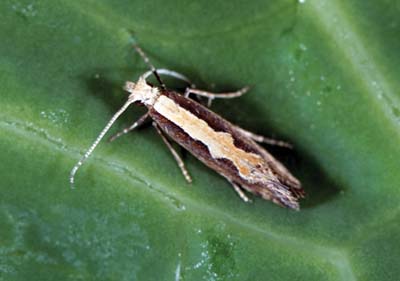
Diamondback moth, Plutella xylostella, adult.
(Photographer: J. Castner, University of Florida)
Vegetable crops that are eaten include broccoli, Brussels sprouts, cabbage, cauliflower, collard, mustard, radish, turnip, and watercress. Cruciferous weeds are important alternate hosts early in the season. Larval feeding causes plant damage. The larvae remove foliage tissue except for leaf veins and can be very damaging to seedlings and may disrupt head formation in cabbage. Sampling for diamondback moth is accomplished by making counts of larvae or by the level of damage seen. Some economic thresholds are established. Natural enemies are present in the field but insecticides are usually applied in order to manage populations in the field. Resistance to insecticides is a serious problem. Some strains of Bacillus thuringiensis are used effectively. Cultural practices may also be used, such as host plant resistance, crop diversity, crop rotation, planting clean transplants, and the removal of alternate weed hosts. Recently, a pheromone for mating disruption has become available.
Images
To save the Web-optimized images shown below to your hard drive:
|
Click to access Display and Print quality images. |
|
Click to access Display and Print quality images. |
|
Click to access Display and Print quality images. |
|
Click to access Display and Print quality images. |
|
Click to access Display and Print quality images. |